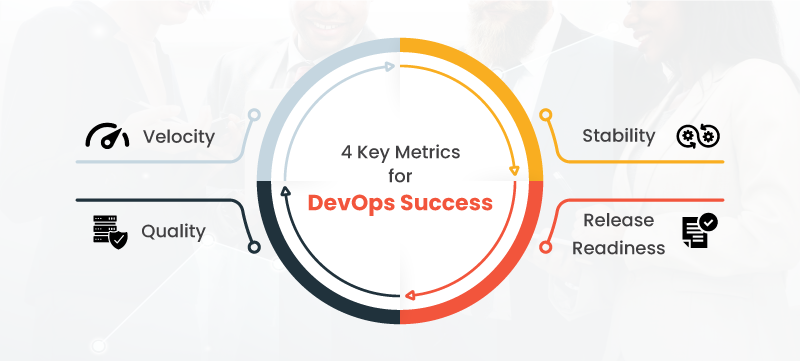
In recent years, DevOps has become an imperative component for software development. It made software delivery faster and much more flexible. However, measuring DevOps success is often elusive. The reasons are myriad, but ‘different perceptions of DevOps’ play the spoilsport.
People within an organization have different perceptions of DevOps. Some think it’s a culture change, some believe it simply fuses Dev and Ops, and others say it’s all about automation and tooling. With so many opinions fogging DevOps, a definitive understanding of DevOps success has become abstruse.
Despite this conundrum, there are four key DevOps metrics that can help you measure the performance of the software delivery process. The four crucial metrics are Velocity, Quality, Stability, and Release Readiness.
Also Read: Continuous Integration: The DevOps Approach Which Fuels Productivity
If you have deployed efficient DevOps methodologies and tools, then measuring the success using these metrics will be a cakewalk. Let’s delve into the details:
4 Key Metrics for DevOps Success

1) Velocity Metrics
Velocity metrics refer to all the essential elements contributing to speed-to-market.
- Build Time: The time duration it takes to build a package. The time should include components pertaining to automated and manual processes involved. This provides the room to improve speed and reliability.
- Test Time: The time duration it takes for a build package to pass through the entire testing phase. The testing phase basically includes unit testing, functional testing, performance testing, and security testing. This approach betters the testing speed and shift testing towards the left in the software development lifecycle.
- Deploy Time: The total time it takes for the deployment of a build package. This helps understand whether deployments are causing excessive delays or demanding massive run sheets or manual processes.
- Deployment Frequency: The number of deployments per application in a given time. It indicates how frequently the code is being deployed into SIT, pre-production, and production. Based on the inputs gleaned off this approach, one can decide as to how to enhance the frequency of deployments.
- Environ Provisioning Time: The time duration for provisioning a new environment like Dev and integrated test setup. This helps understand the efforts needed for developing environments, the time it takes to derive a stable environment, and the environment’s impact on project work.
- Code Change Volume: The number of new user stories or code changes deployed per build. This helps measure the value of deployment to the end-users.
- Commit Frequency: The number of commits per build. This reveals how frequently developers are pushing the code to the source base.
- Merge Frequency: The number of mergers that occurred for a branch in a specific period. This helps ensure that the developers merge their work frequently and that development is on par with the latest code set.
DevOps success is not entirely about focusing on production speed. One needs to take heed of quality as well. Releasing changes biweekly is pointless if the code quality is terrible. Instead, try to shift QA checks early into development and ensure the package is checking all the boxes.
Also Read: DevOps for AI: Make AI Operationalization a Core Business Objective!
2) Quality Metrics
Quality metrics focus on all the key elements contributing to the quality of the code.
- Code Quality: The quality of code plays a crucial role in the overall software quality. This aspect impacts how safe, secure, and reliable the end product is. Measuring bugs, vulnerabilities, duplications, technical debt, and pass rate allows you to assess the quality of code. Code quality assurance tools like SonarQube make a developer’s work much simpler by providing a detailed analysis of these quality concerns.
- Test Coverage: The percentage of the codebase that is actually executed by automated test scripts. The higher the test coverage, the lower the risk of performing the refactoring. Tools like Cobertura or coverage.py can help you measure test coverage.
- Test Pass Rate: The percentage of tests passed per build. This includes the percent success of the unit test, functional test, performance test, and security test. Orchestration tools like Jenkins or test tools like Junit and Selenium will fetch you this data.
- Defect Volume: The number of defects per story points delivered in a release. It is counted per thousand lines of code, or KLOC. If the defect density is low, the first thing to do is to check whether the test and prod environs are configured differently, or only the package being tested and passed is getting deployed.
- Defect Leakage: The percentage of defects leaked from the current testing stage to the next stage. It helps determine the effectiveness of local developer unit testing.
- Defect Ageing: The time during which a defect exists. This helps understand how quickly a defect was fixed and how. Tracking tools like JIRA, ServiceNow, or Remedy can glean defect count and aging data.
With velocity and quality blended into development, operations need to be addressed. In a nutshell, DevOps is about bridging the gap between Dev and Ops with shared responsibilities and common objectives.
Also Read: Achieving Continuous Application Security with DevSecOps
To embrace this collaborative culture, we must assess if our processes and automation are stable, reliable, and repeatable with the below metrics:
3) Stability Metrics
- Build Success Rate: The percentage of successful builds per release.
- Deployment Success Rate: The percentage of successful deployments per release.
- Environment Provisioning Success Rate: The percentage of environments created successfully per release.
- Change Success Rate: The percentage of changes that are successful in production.
- MTTR (Mean Time to Recover): The time taken to recover from an incident due to a defect. It is also the time taken to fix a defect and dole it to production.
- Deployment Downtime: The amount of time during which the service is down during deployment. It helps you fathom the cost of deployment over service loss.
- Uptime: The time during which the service is completely available. Downtime and uptime data can be gathered from data centers or cloud platforms.
Once you have addressed the three prime components of delivery, namely velocity, quality, and stability, then you are all set to push releases to production.
4) Release Readiness Metrics
- Release Confidence: The addition of test pass rate, build pass rate, deployment pass rate, environmental provisioning pass rate, code quality pass rate, and change success rate.
- Release Cycle Time: The time duration from the start of code development to successful deployment into production. It indicates the efficiency of the software development processes. In addition, it helps identify automation needs and redundant processes.
- Release Frequency: The frequency at which changes are released into production.
- Release size: The number of story points per release.
- End to End Traceability: The number or percentage of requirements connected with test cases.
Tracking tools such as JIRA can help you quickly gather the aforementioned release-related metrics.
Closing Thoughts

DevOps adoption can be an uphill climb. The results often don’t reach high expectations. To steer clear of the challenges and do DevOps right, one must focus on the mentioned DevOps metrics. Measuring these metrics will help you proactively identify bottlenecks and foster a culture of kaizen.
Struggling to Achieve DevOps Success? Veritis Can Help!
With over a decade-long industry presence, Veritis has hands-on experience helping many clients, including Fortune 500 companies, embark on a DevOps transformation.
Our DevOps experts can help you promote a DevOps mindset across the organization to enable efficient, faster, and higher-quality software delivery. Join forces with us to achieve DevOps success.
More Articles:
